South Coast
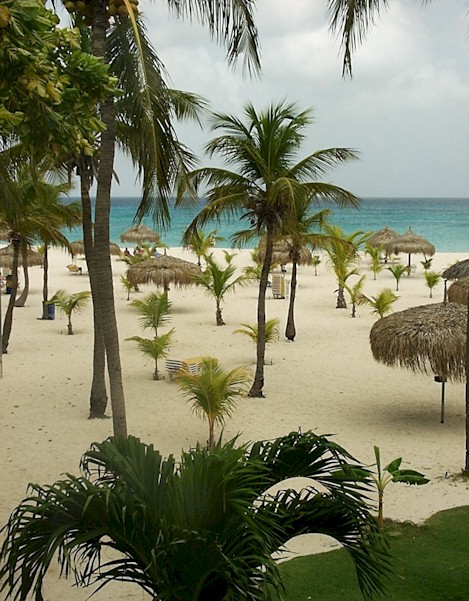
The so-called south coast of Aruba (it actually faces west as much as south) is the lee side of the island and contains most of the population and all the resorts and 'safe' swimmable beaches. Somehow our internet-based research on beaches turned out to be shockingly accurate and the beach we stayed at (Manchebo) is pretty much exactly what we would have wanted had we surveyed the island first.
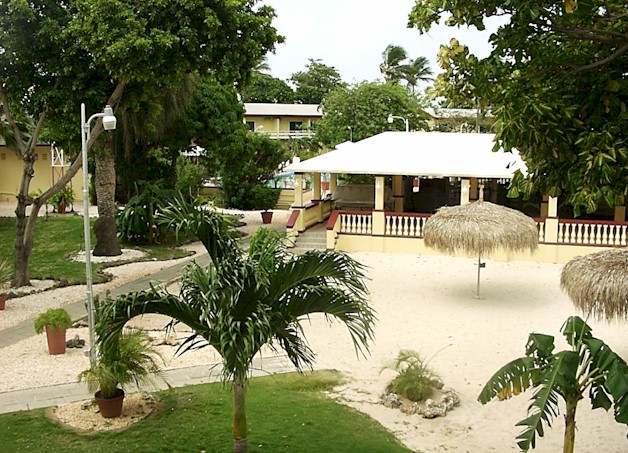
We stayed at the Manchebo Beach resort (this and the previous picture are taken from our balcony there) which is just a little south of the center of the low-rise area. Coming up the coast from the capital Oranjestad one first reaches the low-rise area which has nice wide beaches, a lot of extended stay lodging, time-shares, apartments and the like, and is relatively quiet. The next area north is the high-rise area which is pretty much the spring-break style chaos that every Caribbean city seems to have at least a component of. Most of the hotels and restaurants up that way are American chains (although some good restaurants can be found). Life in Aruba (as a visitor at least) consists mostly of waking up at some point and wandering down to the beach, where you claim a palapa (the little thatched shade mechanism) and a lounge chair. Later if you work up the energy you can wander away from your palapa in short bursts to swim, consume tropical drinks, or go in search of more suntan lotion.
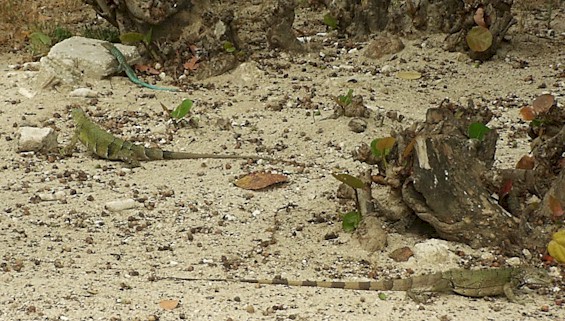
That was an iguana intermission. This is more assorted lizards including two iguanas and an exciting teal-colored thing on that rock in the back left. I spent the better part of a morning herding these three lizards together so they could be in one photograph so I hope everyone reading this appreciates that. Iguanas are pretty much everywhere except the high-rise area (where they would be tortured by intoxicated teenagers). Note that herding them is not a recognized form of lizard torture. It's entirely possible that they even like it. If one is interested in lizard-herding as a career I highly recommend you keep them away from the trees because they cheat and withdraw from the playing field as soon as they get near one.
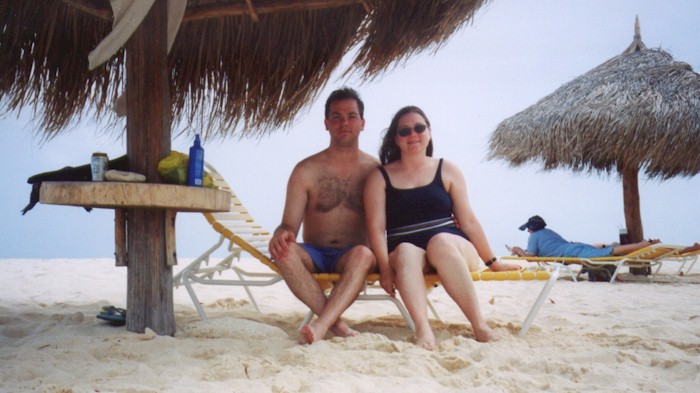
Here we are under the palapa of the day on some given day. Melanie strategically waited until a nearby palapa was abandoned so she could use it in the staging of this picture. Waiting for a nearby palapa to become vacant strictly for the sake of taking a picture is a time-consuming pastime that requires hours of lying on the beach. Nevertheless we persevered and here is the proof.
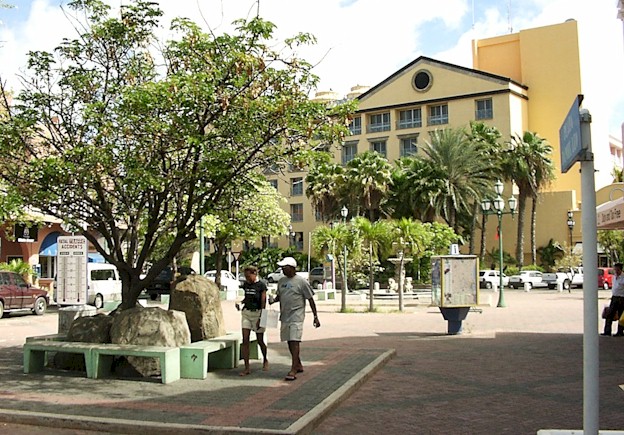
The airport is just south of Oranjestad and the cruise port is right in the middle of it so pretty much every one arriving on the island has to start there. It's also the official home of all the traffic in Aruba. For an island of 95,000 people it's amazing how many cars there can be driving around Oranjestad. The waterfront is Caribbean standard featuring lots of duty-free shopping, faux-Mexican entertainment complexes and people who want to braid your hair. A block or so inland there are lots of excitingly pastel Dutch-looking buildings and some stores where locals actually shop. I suppose we should mention that Aruba is a Dutch protectorate and technically Dutch is the official language but you'll only hear it being spoken by Dutch students who came to Aruba to work for the summer.
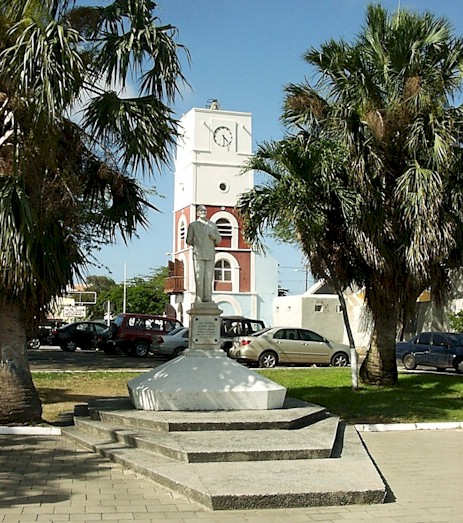
The language of the people is Papiamento which is a fun mix of English, Spanish and Dutch with some French and Mandarin thrown in and a few words randomly invented from a Scrabble tile bag apparently. This incidentally is a fort. That building behind the cars is the grand edifice of colonial Oranjestad. So it won't be much of a surprise that it never successfully repelled an attack. Not that there have been a whole lot in Aruba. The clock tower is the Willem III Tower. This can be toured along with a couple small museums on Aruban history, geology and world currency (no, seriously). Otherwise, Oranjestad is mostly for shopping and dining and sitting at traffic lights.

Here is the Aruban parliament which is actually another place they probably speak Dutch. Melanie is standing in the shade because I made her walk all over Oranjestad and we were mostly dehydrated by this point. Standing in shade is a fairly major hobby in Aruba. We did it in most of the major cities on the island and assorted beaches as well.
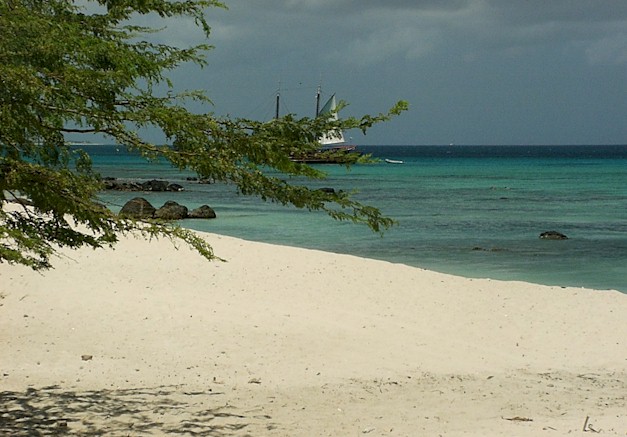
North of the cacophany of the high-rise area is the northern tip of the island which once again becomes quiet and idyllic and has impossibly beautiful beaches like Arashi beach, shown here. Arashi beach is the northern terminus of the bus line that runs up from Oranjestad and is a very good use of the bus indeed. It will drop you off right at the beach and periodically return to take you back to your hotel. The buses, like most of Aruba take either US or Aruban currency. Aruban currency is more fun because half the coins are square.
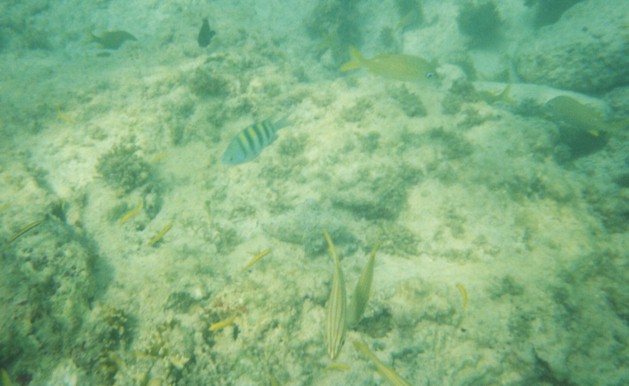
Arashi is a great place to snorkel although you have to swim out to the kelp beds where some old pilings seem to attract the most coral and fish life. Often it was possible to stand up waist-deep in water as much as 200 yards (180m) from shore.

Here's a small composite of snorkelling photos. Back on shore behind us you can see a lighthouse on the far left, and the communal style mega-palapas that Arashi beach features. You may want these in case of a storm. Or you can just make basecamp under a random divi tree like we did. Divi trees are the official strange tree of Aruba. They all point south because that's the way wind blows.
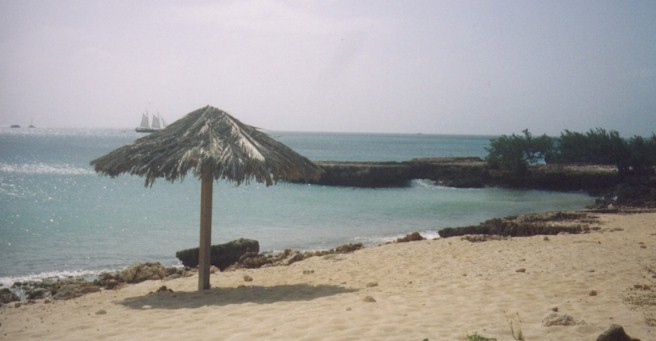
Another great spot for snorkelling is just south of Arashi and is called Boca Catalina. Occassionally a tour boat of snorkellers (or revelers) will float up and dock in one of the little harbors of Boca Catalina and disperse snorkellers in all directions. You should then pick a different harbor. This particular one we had all to ourselves for the afternoon. The shore is a bit rocky here so getting out into deeper water is a bit tricky (in flippers especially) but definitely worth it.
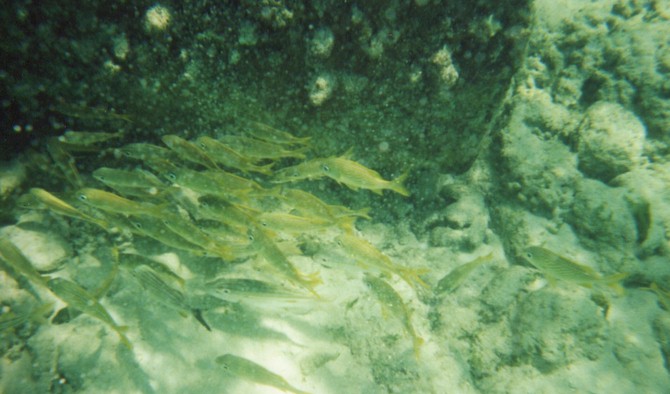
Here's a swarm of yellow fish because the puffer fish I chased all over Boca Catalina refused to pose for a photo. Parrot fish, angel fish, snappers, and some very fast orange things are also common.
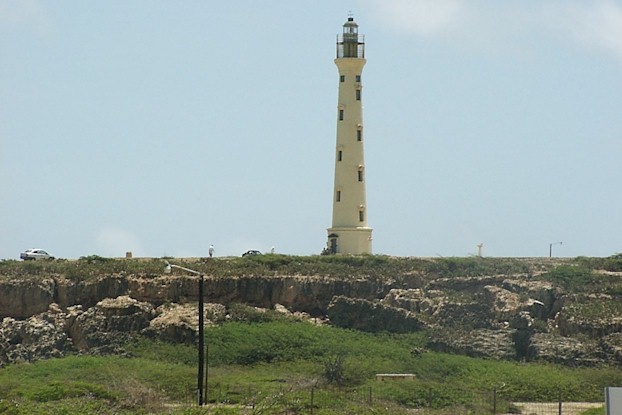
At the very north end of the south coast (yeah that doesn't really make sense) is the California Lighthouse. It's not really all that exciting unless you're big on lighthouses but it's a mandatory stop on the tour of Aruba (see the north coast page for more on this subject). From here you can see, well, the same view you have everywhere else in Aruba. Water, some brightly colored houses and some lumpy looking hills in the interior of the island. However, having toured pretty much the whole coast we can tell you that it's not worth renting a car to find remote beaches. There aren't any, and Arashi and Boca Catalina are probably the nicest we went to. Plus they were more or less deserted and are easily bus-accessible from the hotel districts.
 The so-called south coast of Aruba (it actually faces west as much as south) is the lee side of the island and contains most of the population and all the resorts and 'safe' swimmable beaches. Somehow our internet-based research on beaches turned out to be shockingly accurate and the beach we stayed at (Manchebo) is pretty much exactly what we would have wanted had we surveyed the island first.
The so-called south coast of Aruba (it actually faces west as much as south) is the lee side of the island and contains most of the population and all the resorts and 'safe' swimmable beaches. Somehow our internet-based research on beaches turned out to be shockingly accurate and the beach we stayed at (Manchebo) is pretty much exactly what we would have wanted had we surveyed the island first. The so-called south coast of Aruba (it actually faces west as much as south) is the lee side of the island and contains most of the population and all the resorts and 'safe' swimmable beaches. Somehow our internet-based research on beaches turned out to be shockingly accurate and the beach we stayed at (Manchebo) is pretty much exactly what we would have wanted had we surveyed the island first.
The so-called south coast of Aruba (it actually faces west as much as south) is the lee side of the island and contains most of the population and all the resorts and 'safe' swimmable beaches. Somehow our internet-based research on beaches turned out to be shockingly accurate and the beach we stayed at (Manchebo) is pretty much exactly what we would have wanted had we surveyed the island first. We stayed at the Manchebo Beach resort (this and the previous picture are taken from our balcony there) which is just a little south of the center of the low-rise area. Coming up the coast from the capital Oranjestad one first reaches the low-rise area which has nice wide beaches, a lot of extended stay lodging, time-shares, apartments and the like, and is relatively quiet. The next area north is the high-rise area which is pretty much the spring-break style chaos that every Caribbean city seems to have at least a component of. Most of the hotels and restaurants up that way are American chains (although some good restaurants can be found). Life in Aruba (as a visitor at least) consists mostly of waking up at some point and wandering down to the beach, where you claim a palapa (the little thatched shade mechanism) and a lounge chair. Later if you work up the energy you can wander away from your palapa in short bursts to swim, consume tropical drinks, or go in search of more suntan lotion.
We stayed at the Manchebo Beach resort (this and the previous picture are taken from our balcony there) which is just a little south of the center of the low-rise area. Coming up the coast from the capital Oranjestad one first reaches the low-rise area which has nice wide beaches, a lot of extended stay lodging, time-shares, apartments and the like, and is relatively quiet. The next area north is the high-rise area which is pretty much the spring-break style chaos that every Caribbean city seems to have at least a component of. Most of the hotels and restaurants up that way are American chains (although some good restaurants can be found). Life in Aruba (as a visitor at least) consists mostly of waking up at some point and wandering down to the beach, where you claim a palapa (the little thatched shade mechanism) and a lounge chair. Later if you work up the energy you can wander away from your palapa in short bursts to swim, consume tropical drinks, or go in search of more suntan lotion.
 That was an iguana intermission. This is more assorted lizards including two iguanas and an exciting teal-colored thing on that rock in the back left. I spent the better part of a morning herding these three lizards together so they could be in one photograph so I hope everyone reading this appreciates that. Iguanas are pretty much everywhere except the high-rise area (where they would be tortured by intoxicated teenagers). Note that herding them is not a recognized form of lizard torture. It's entirely possible that they even like it. If one is interested in lizard-herding as a career I highly recommend you keep them away from the trees because they cheat and withdraw from the playing field as soon as they get near one.
That was an iguana intermission. This is more assorted lizards including two iguanas and an exciting teal-colored thing on that rock in the back left. I spent the better part of a morning herding these three lizards together so they could be in one photograph so I hope everyone reading this appreciates that. Iguanas are pretty much everywhere except the high-rise area (where they would be tortured by intoxicated teenagers). Note that herding them is not a recognized form of lizard torture. It's entirely possible that they even like it. If one is interested in lizard-herding as a career I highly recommend you keep them away from the trees because they cheat and withdraw from the playing field as soon as they get near one. Here we are under the palapa of the day on some given day. Melanie strategically waited until a nearby palapa was abandoned so she could use it in the staging of this picture. Waiting for a nearby palapa to become vacant strictly for the sake of taking a picture is a time-consuming pastime that requires hours of lying on the beach. Nevertheless we persevered and here is the proof.
Here we are under the palapa of the day on some given day. Melanie strategically waited until a nearby palapa was abandoned so she could use it in the staging of this picture. Waiting for a nearby palapa to become vacant strictly for the sake of taking a picture is a time-consuming pastime that requires hours of lying on the beach. Nevertheless we persevered and here is the proof. The airport is just south of Oranjestad and the cruise port is right in the middle of it so pretty much every one arriving on the island has to start there. It's also the official home of all the traffic in Aruba. For an island of 95,000 people it's amazing how many cars there can be driving around Oranjestad. The waterfront is Caribbean standard featuring lots of duty-free shopping, faux-Mexican entertainment complexes and people who want to braid your hair. A block or so inland there are lots of excitingly pastel Dutch-looking buildings and some stores where locals actually shop. I suppose we should mention that Aruba is a Dutch protectorate and technically Dutch is the official language but you'll only hear it being spoken by Dutch students who came to Aruba to work for the summer.
The airport is just south of Oranjestad and the cruise port is right in the middle of it so pretty much every one arriving on the island has to start there. It's also the official home of all the traffic in Aruba. For an island of 95,000 people it's amazing how many cars there can be driving around Oranjestad. The waterfront is Caribbean standard featuring lots of duty-free shopping, faux-Mexican entertainment complexes and people who want to braid your hair. A block or so inland there are lots of excitingly pastel Dutch-looking buildings and some stores where locals actually shop. I suppose we should mention that Aruba is a Dutch protectorate and technically Dutch is the official language but you'll only hear it being spoken by Dutch students who came to Aruba to work for the summer. The language of the people is Papiamento which is a fun mix of English, Spanish and Dutch with some French and Mandarin thrown in and a few words randomly invented from a Scrabble tile bag apparently. This incidentally is a fort. That building behind the cars is the grand edifice of colonial Oranjestad. So it won't be much of a surprise that it never successfully repelled an attack. Not that there have been a whole lot in Aruba. The clock tower is the Willem III Tower. This can be toured along with a couple small museums on Aruban history, geology and world currency (no, seriously). Otherwise, Oranjestad is mostly for shopping and dining and sitting at traffic lights.
The language of the people is Papiamento which is a fun mix of English, Spanish and Dutch with some French and Mandarin thrown in and a few words randomly invented from a Scrabble tile bag apparently. This incidentally is a fort. That building behind the cars is the grand edifice of colonial Oranjestad. So it won't be much of a surprise that it never successfully repelled an attack. Not that there have been a whole lot in Aruba. The clock tower is the Willem III Tower. This can be toured along with a couple small museums on Aruban history, geology and world currency (no, seriously). Otherwise, Oranjestad is mostly for shopping and dining and sitting at traffic lights. Here is the Aruban parliament which is actually another place they probably speak Dutch. Melanie is standing in the shade because I made her walk all over Oranjestad and we were mostly dehydrated by this point. Standing in shade is a fairly major hobby in Aruba. We did it in most of the major cities on the island and assorted beaches as well.
Here is the Aruban parliament which is actually another place they probably speak Dutch. Melanie is standing in the shade because I made her walk all over Oranjestad and we were mostly dehydrated by this point. Standing in shade is a fairly major hobby in Aruba. We did it in most of the major cities on the island and assorted beaches as well. North of the cacophany of the high-rise area is the northern tip of the island which once again becomes quiet and idyllic and has impossibly beautiful beaches like Arashi beach, shown here. Arashi beach is the northern terminus of the bus line that runs up from Oranjestad and is a very good use of the bus indeed. It will drop you off right at the beach and periodically return to take you back to your hotel. The buses, like most of Aruba take either US or Aruban currency. Aruban currency is more fun because half the coins are square.
North of the cacophany of the high-rise area is the northern tip of the island which once again becomes quiet and idyllic and has impossibly beautiful beaches like Arashi beach, shown here. Arashi beach is the northern terminus of the bus line that runs up from Oranjestad and is a very good use of the bus indeed. It will drop you off right at the beach and periodically return to take you back to your hotel. The buses, like most of Aruba take either US or Aruban currency. Aruban currency is more fun because half the coins are square. Arashi is a great place to snorkel although you have to swim out to the kelp beds where some old pilings seem to attract the most coral and fish life. Often it was possible to stand up waist-deep in water as much as 200 yards (180m) from shore.
Arashi is a great place to snorkel although you have to swim out to the kelp beds where some old pilings seem to attract the most coral and fish life. Often it was possible to stand up waist-deep in water as much as 200 yards (180m) from shore. Here's a small composite of snorkelling photos. Back on shore behind us you can see a lighthouse on the far left, and the communal style mega-palapas that Arashi beach features. You may want these in case of a storm. Or you can just make basecamp under a random divi tree like we did. Divi trees are the official strange tree of Aruba. They all point south because that's the way wind blows.
Here's a small composite of snorkelling photos. Back on shore behind us you can see a lighthouse on the far left, and the communal style mega-palapas that Arashi beach features. You may want these in case of a storm. Or you can just make basecamp under a random divi tree like we did. Divi trees are the official strange tree of Aruba. They all point south because that's the way wind blows. Another great spot for snorkelling is just south of Arashi and is called Boca Catalina. Occassionally a tour boat of snorkellers (or revelers) will float up and dock in one of the little harbors of Boca Catalina and disperse snorkellers in all directions. You should then pick a different harbor. This particular one we had all to ourselves for the afternoon. The shore is a bit rocky here so getting out into deeper water is a bit tricky (in flippers especially) but definitely worth it.
Another great spot for snorkelling is just south of Arashi and is called Boca Catalina. Occassionally a tour boat of snorkellers (or revelers) will float up and dock in one of the little harbors of Boca Catalina and disperse snorkellers in all directions. You should then pick a different harbor. This particular one we had all to ourselves for the afternoon. The shore is a bit rocky here so getting out into deeper water is a bit tricky (in flippers especially) but definitely worth it. Here's a swarm of yellow fish because the puffer fish I chased all over Boca Catalina refused to pose for a photo. Parrot fish, angel fish, snappers, and some very fast orange things are also common.
Here's a swarm of yellow fish because the puffer fish I chased all over Boca Catalina refused to pose for a photo. Parrot fish, angel fish, snappers, and some very fast orange things are also common. At the very north end of the south coast (yeah that doesn't really make sense) is the California Lighthouse. It's not really all that exciting unless you're big on lighthouses but it's a mandatory stop on the tour of Aruba (see the north coast page for more on this subject). From here you can see, well, the same view you have everywhere else in Aruba. Water, some brightly colored houses and some lumpy looking hills in the interior of the island. However, having toured pretty much the whole coast we can tell you that it's not worth renting a car to find remote beaches. There aren't any, and Arashi and Boca Catalina are probably the nicest we went to. Plus they were more or less deserted and are easily bus-accessible from the hotel districts.
At the very north end of the south coast (yeah that doesn't really make sense) is the California Lighthouse. It's not really all that exciting unless you're big on lighthouses but it's a mandatory stop on the tour of Aruba (see the north coast page for more on this subject). From here you can see, well, the same view you have everywhere else in Aruba. Water, some brightly colored houses and some lumpy looking hills in the interior of the island. However, having toured pretty much the whole coast we can tell you that it's not worth renting a car to find remote beaches. There aren't any, and Arashi and Boca Catalina are probably the nicest we went to. Plus they were more or less deserted and are easily bus-accessible from the hotel districts.